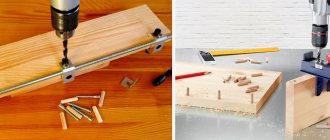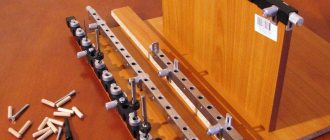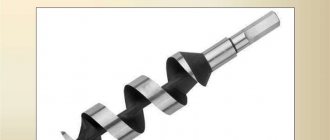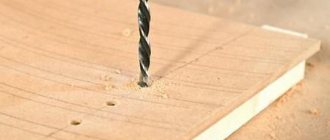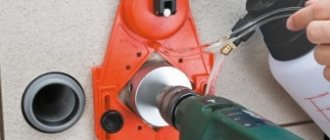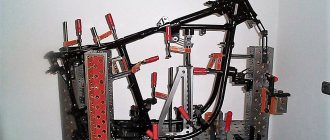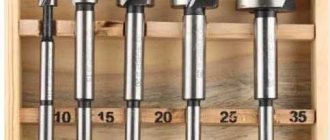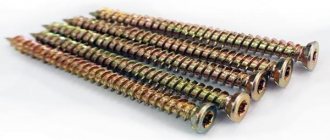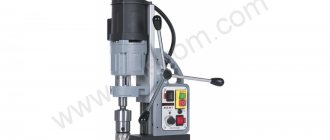Classification of conductors
The main function of jigs is to ensure straightness in drilling wooden surfaces throughout the entire depth of the hole. Such devices are used quite often in metal processing and, as a rule, are supplied directly with the machine. Due to the need to create such holes in furniture production in large quantities, such devices are in great demand among craftsmen.
There are the following types of conductors:
- Invoices. This type does not require fixation before starting work. They are practical and simple, but they should only be used with one hand unless the drill is mounted on a special stand. You can make such a conductor yourself easily and simply, but it must be used in chipboards.
- Rotary. With their help, you can make two holes in planes that are adjacent to each other. This operation is performed thanks to a folding bracket.
- Jig for drilling holes at an angle. This option is used in highly specialized industries. It can be used to drill holes at an angle. Sometimes used in conjunction with slip-on conductors.
- Sliding. They are designed to drill holes in multiple locations while keeping the original settings the same. They are mainly used by professionals and require little experience to operate successfully.
If the jig has sufficient rigidity, then it can be used not only on flat planes, but also for curved pipes, etc. In this case, it is secured with a clamp. But under no circumstances should it be used for fastening on wooden surfaces, as it can damage the furniture. You can buy it in a store, or you can also make it yourself.
The jig is in fact a template for making holes, with the help of which such work can be done with maximum accuracy. Due to the simplicity of the structure, they are often used not only in the areas of furniture production. In particular, they are actively used in the field of mechanical engineering for drilling holes in various workpieces, etc. We should not forget about the furniture industry, where such a device is used for various needs when assembling furniture fittings.
Classification
According to the characteristics of their use, conductors are classified into the following types:
- Invoices. These are simple and mobile devices that do not require fixation, but are held by hand. In view of this, drilling using these jigs has to be done with one hand. They are used mainly when processing chipboard and MDF boards. The devices in question are easy to create yourself.
- Rotary. These conductors are equipped with brackets. Designed to perform drilling in two adjacent planes in one pass.
- Sliding. These devices are designed to create multiple holes without changing settings. They belong to professional equipment requiring appropriate skills.
- Angular (at an angle). They are presented in highly specialized versions, designed for making holes at different angles. Often made according to an overhead scheme.
Features of self-production
When designing a conductor for confirmation, it is necessary to correctly calculate what functions it will have to perform in the future. It should be done for the most commonly used fasteners in the house. If such a device is required by furniture makers for constant work, then it is better to buy a factory model, which is distinguished by great precision. In addition, manufacturers often include additional fasteners, stops and templates in the kit.
DIY furniture conductors and templates
How conductors are made is now clear, as is their necessity for furniture production.
Not only conductors, but also templates are needed in furniture production. The simplest template will sometimes save a lot of time and allow drilling to be no less accurate than a jig.
For example, the simplest metal prefabricated template, consisting of two sheet blanks measuring 130x70 mm and a steel square with a cross-section of 20 mm. They are connected to each other by screws at the top of the structure - this is how they are attached to the square. The square is drilled for the bushings, where the latter are pressed. Such a device for drilling holes in the end of a part made of chipboard will make it possible to drill without thinking about marking and perpendicular drilling. And the price of this equipment is below any idea of savings.
Instead of metal, you can and should use those materials that are inexpensive and easy to process.
- Plywood.
- Textolite or fiberglass - preferably thick.
- Hardwood.
- Hardboard or its equivalent.
It must be borne in mind that these materials are short-lived, and so that the devices do not have to be made every day, it is quite reasonable to press metal tubes into them.
In conclusion, it is worth summing up what has been said. Making a conductor or template yourself or buying it in a store is a matter for everyone individually. If a home craftsman needs to make some furniture in a single copy and there is material for a conductor, as well as the possibility of making it, you can use this. It is possible that such equipment will never be useful to the master again.
But if even a small furniture workshop is engaged in the production of mass-produced furniture, and it employs enough people, it is probably easier to purchase something ready-made, especially since they will need these indispensable assistants to the craftsmen in several copies.
In the latter case, it makes sense to purchase more expensive, accurate and wear-resistant jigs instead of making homemade ones, which are less accurate and durable.
Design for confirmations and dowels
A furniture jig for drilling holes for dowels and confirmations is a very necessary device for furniture makers. Especially if chipboard material is used.
For these purposes, two types of conductor are used:
- Dowel jig with clamp fastening with many functions. The basis of this design is a corner made of thick aluminum. Since the device is quite long, there is an additional fastener in the middle. When turning the angle ninety degrees, the increased thickness of the device helps a lot. The bushings on the structure are located at the distance most often used for confirmations and dowels in furniture production.
- A two-slider jig, which is used to make a hole in two parts fastened together. The design consists of two strips that are connected by fasteners. It has several holes, so you can install devices at different widths.
Jig for drilling holes
A drilling jig, as a rule, is a bar (plate) with holes and bushings (sleeves). Using a jig it is much easier, for example, to drill pipes.
As for furniture production, they are also used here, although relatively recently.
With the help of such equipment, the manufacturer is relieved of the following problems:
- Marking.
- Punching (point depressions in the material for a drill).
- Drilling while maintaining perpendicularity.
The latter is especially difficult to achieve, since it requires serious skills acquired only over the years.
Some operations, for example, drilling for dowels (short wooden rods designed for hidden joining of parts), require very precise markings, and no less accurate drilling at an angle of 90°.
With such a device as a conductor, these tasks are solved easily and simply.
Scope of use
Furniture jigs are devices that no furniture maker can do without while working. Such devices allow you to avoid the main problem in furniture production, namely the drill entering at the wrong angle. If you make such a mistake, it is very difficult or even impossible to correct it later. Such a device not only makes it possible to correctly direct the drill during operation, but also allows the tool to constantly maintain the desired trajectory (flat, perpendicular or at an angle).
Such devices are used both in the design and production of furniture, and during assembly, when there is a need to make holes for fastening elements together. Often, for such actions, conductors are used for firmmats or dowels, without which it is impossible to make straight holes. Also, you cannot do without this device if you need to make holes at an angle or in the end of a thin slab (it is especially important to use the device when working with chipboards).
When drilling holes using this design, the process itself is quick and simple. The fastener allows you to do work at any distance from the edge of the slab, as well as regardless of its width.
In the furniture industry, dowels are often used as fasteners. But at the same time, this option has already existed for a long time, and their use requires the presence of a drilling jig when working. The only condition and at the same time a problem is the fact that the parts being connected to each other must have a right angle during operation. Therefore, such elements must be located exactly perpendicular to each other. When making holes for dowels and adding parts, it will be very difficult to do without a jig.
DIY jig for drilling holes
As already mentioned, depending on the scope of use and design, you can make some options yourself, thanks to which you will save a significant amount.
Before work, find the required drawing of the device and make everything strictly according to it.
Tools required for work:
- welding machine;
- Bulgarian;
- drill;
- locksmith supplies.
To make the simplest version of the conductor with your own hands, we perform the following steps:
- take reinforcement measuring 10 by 10 mm with a square cross-section;
- cut a piece of the required length and sand it with sandpaper;
- make markings for the template holes. In this case, it is not allowed for the center to approach the edge by more than 8 mm, this is almost half the thickness of the chipboard sheet. Also, according to the standards, a distance of 32 mm must be maintained between centers;
- after marking the centers, make holes in them 5 mm in diameter;
- to make an emphasis, take a metal plate 2.5 mm wide and 1 mm thick. Bend it at an angle of 90 degrees, and then, together with a piece of prepared reinforcement and fastening in a clamp, make a place for the thread;
- cut the thread and connect the two parts into one structure. The device is ready.
As you can see, such a device is very simple to make yourself, but it will greatly simplify your work if you are making furniture. If you are doing this exclusively as an amateur, then this option will be sufficient. If you can’t do it yourself, buy a ready-made option, perhaps the simplest and most inexpensive.
But professional equipment will cost much more; it makes sense to purchase it even when we are talking about at least small-scale mass production. But with its help you can easily and quickly connect pieces of furniture or repair it.
So, you have learned what a hole jig is and how it helps in furniture production. This device can be purchased ready-made or made by yourself.
Read also: Horizontal wood milling machine
A drilling jig is an indispensable attribute in large-scale production, no matter what kind. Where there is a lot of drilling, it is really necessary, especially when production is serial or mass.
With the help of a conductor, production is greatly accelerated and the worker's work is made easier.
